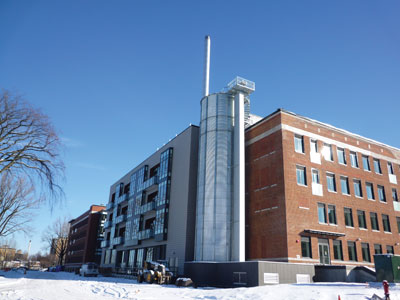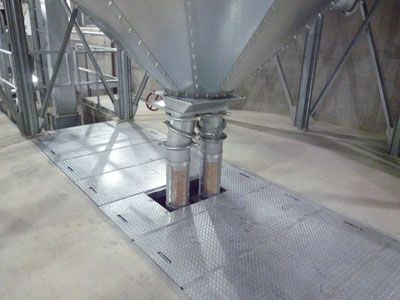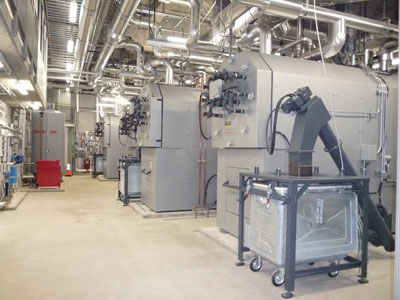
Green Living
October 16, 2012
By Viessmann Manufacturing Co. Inc.
A unique community in downtown Quebec City is setting the standard for energy efficiency, including a four-boiler biomass combustion system to heat the dwelling and domestic hot water.
A unique community in downtown Quebec City is setting the standard for energy efficiency, including a four-boiler biomass combustion system to heat the dwelling and domestic hot water.
 |
|
| La Cité Verte employs a biomass district heating system for its space heating and domestic hot water (DHW) needs.
|
There are very few properties in the Quebec City core large enough to accommodate the construction of new housing, especially since preserving green spaces has become a top priority. The obvious solution is to combine living space with green spaces, which is precisely what SSQ Financial Group has done with La Cité Verte (The Green City).
The Site
The project site, a 93,000 m2 parcel of land in the Saint-Sacrement district (near the intersection of Chemin Sainte-Foy and Avenue Saint-Sacrement), has a rich history; it has been home to the Saint-Vincent-de-Paul crèche, Hôpital de la Miséricorde (mercy hospital) and the École de puériculture (childcare nursing school). SSQ Financial Group (a Quebec-based insurance, investment/retirement and real estate services institution) acquired the property from the Congrégation des Soeurs du Bon-Pasteur de Québec in 2005.
A Closer Look at La Cité Verte
One of only a handful of such projects in Canada, La Cité Verte takes the concept of sustainable development a step further – to minimize the environmental impacts of a major real estate development project and demonstrate that state-of-the-art technologies and environmental protection can go hand in hand for the well-being of our society and future generations.
La Cité Verte, the first large-scale, multi-residential project in Quebec, comprises green, intelligent buildings. There are more than 800 housing units – including condos, townhouses, apartments and affordable housing – intermingled with community features such as green spaces, stores and services to encourage pedestrian movement and social interaction. The result is a welcoming urban environment that exists in harmony with its natural surroundings.
A Biomass Heating Milestone
La Cité Verte currently employs the most advanced biomass district heating system in North America for its space heating and domestic hot water (DHW) needs. It offers proof that biomass heating is not only a feasible solution for rural areas, but it can also be implemented effectively within an urban setting.
 |
|
| The heating system uses local wood pellets and also has an integrated system that monitors the energy consumption data collected from individual units and district substations.
|
The heating network uses wood pellets, a byproduct from Quebec’s forest industry, as fuel. Wood is a local staple and independent of wide price fluctuations; it is harvested with minimal energy input and contributes to the regional economy. The combustion of premium wood pellets is a clean and environmentally friendly process and, as a carbon-neutral source of energy, it does not contribute to the greenhouse effect.
At the heart of the system is a boiler plant housing four Viessmann Pyrotec KPT-1250 wood-fired boilers (each rated at 1,250 KW) in a 5 MW cascade system. The cascade arrangement provides maximum boiler plant efficiency with a high turndown ratio (1:16) that precisely matches load. The Pyrotec hot water boilers have met their published performance ratings for combustion efficiency (up to 85%) since the biomass heating system went online in October 2011. A 5.2 MW natural gas boiler provides emergency backup for the biomass boilers, and a 650 KW diesel generator will ensure continuous operation of the entire district heating system in the event of an electric power failure.
The boilers heat two 22,000 L buffer water tanks before heated water (90°C supply/50°C return) is distributed through a highly efficient, low-temperature hydronic heating network for district DHW and space heating. Pre-insulated underground piping in the 2.2 km system ranges from 8 in. in diameter exiting the boiler plant to smaller pipes feeding row houses (1 in. diameter) and other buildings throughout the site.
Substations in each Cité Verte building distribute the appropriate amount of heat and calculate fuel bills for the individual units. Water flow throughout the network is driven by a 25 HP pump in the winter and a 5 HP pump during the summer, when space heating requirements are significantly reduced.
A Viessmann boiler control system integrates seamlessly with Smart Heat Network controls developed by Regulvar and project engineers Génécor and Poly-Énergie. The integrated system monitors the energy consumption data collected from individual units and district substations along with boiler data to optimize efficiency throughout the district.
Each dwelling is equipped with a monitoring unit that provides information on daily energy consumption to raise residents’ awareness of their energy usage and encourage energy conservation in the neighbourhood.
La Cité Verte: A Look Ahead
Residential units in three renovated buildings and one new structure constructed during the first phase were completed in late autumn 2011. The first residents moved into the renovated buildings at the beginning of December. The construction of new buildings in Phase 2 will begin in 2013.
 |
|
| At the heart of the system is a boiler plant housing four Viessmann Pyrotec KPT-1250 wood-fired boilers.
|
Representing over $300 million in investments, La Cité Verte has demonstrated the feasibility of taking an environmentally responsible approach to urban development by addressing urban densification, rainwater management, energy efficiency of buildings, waste sorting, transportation management and the preservation of green spaces. When completed, the project will use 30% less energy than conventional developments, and the consumption of potable water will be cut in half – representing a reduction of 131,000,000 litres of water per year, or the equivalent of 52 Olympic-sized pools.
A $22.7-million investment by the Quebec government, a $4.7-million grant from Natural Resources Canada’s Clean Energy Fund and financial assistance from Hydro-Québec affirm the vision and forward thinking of the Quebec community regarding sustainable development. By integrating aspects of sustainability and green technologies in the initial planning stages, La Cité Verte has become a model for future developments in the province and the first green technology showcase in Eastern Canada. The site is also expected to inspire new planning strategies and play a leading role in the adoption of sustainable development practices across Quebec and beyond.
This article was submitted by Viessmann Manufacturing Co. Inc.
Print this page